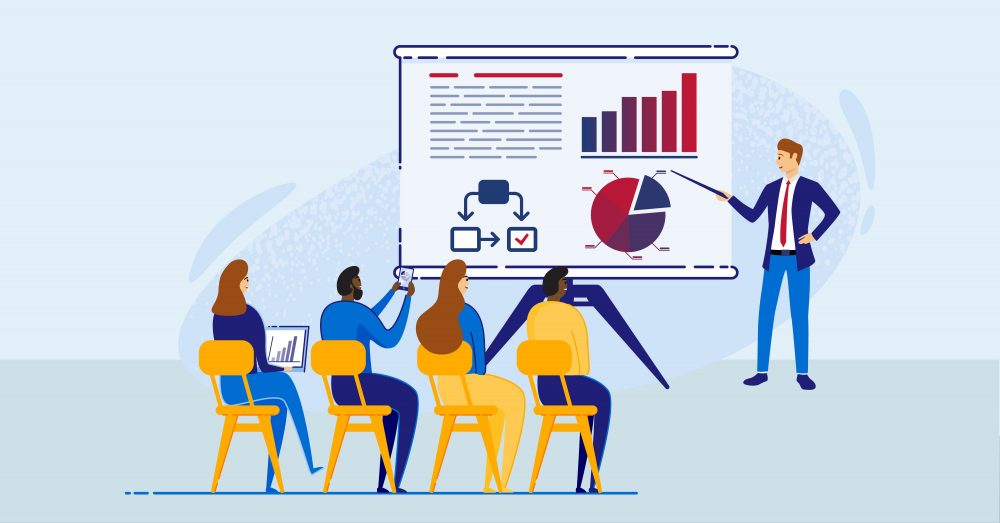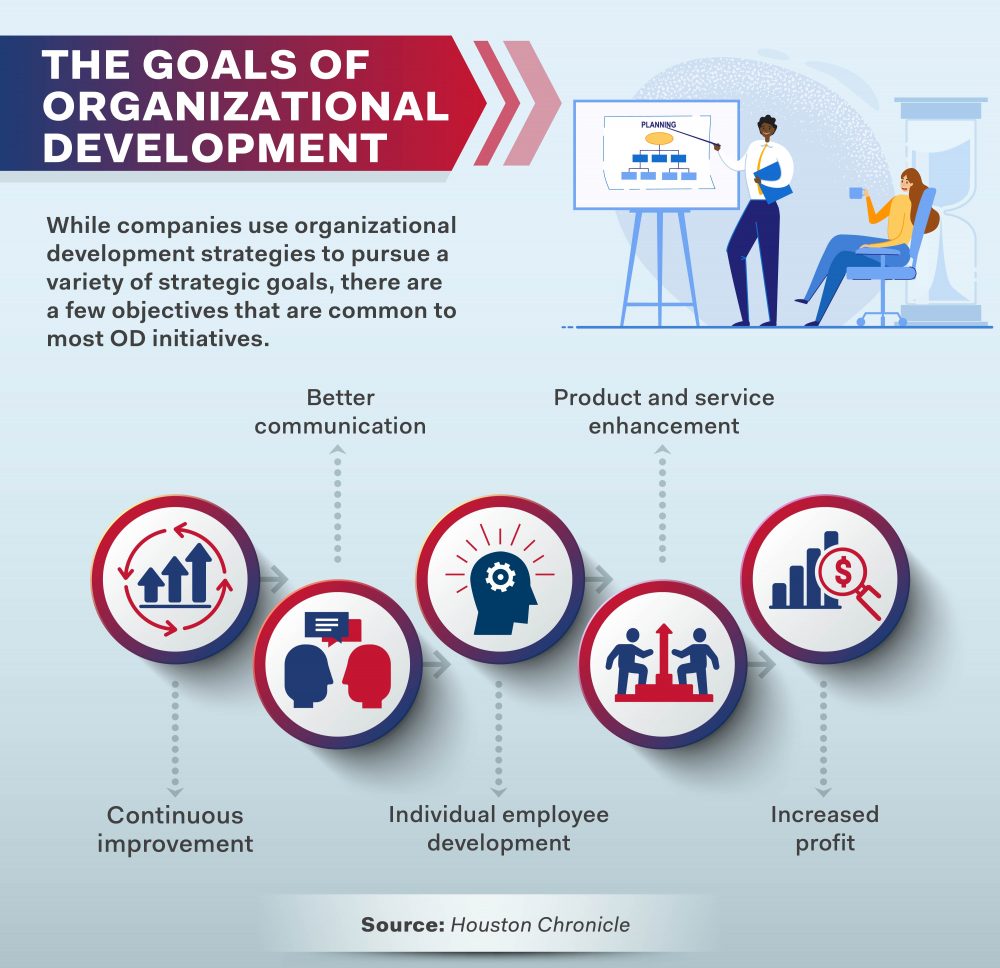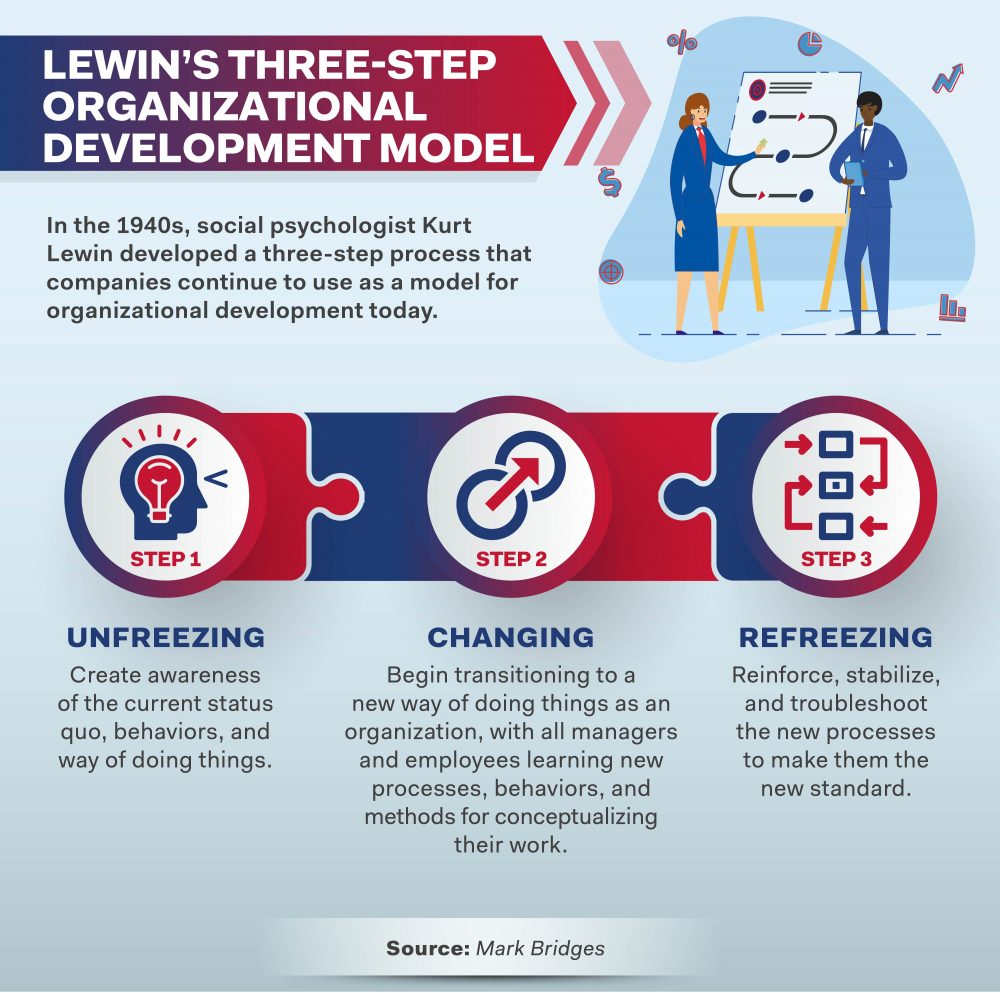Organizational Development Guide: Definition, Process & Development ModelsOrganizational Development Guide: Definition, Process & Development ModelsOrganizational Development Guide: Definition, Process & Development Models
Imagine a family-owned lawn care company that started generations ago as a small business. Over the years, it increased its profit margins and grew by word-of-mouth. However, the firm is struggling to keep up with current e-commerce trends. Its employees have a limited understanding of how to create and maintain a website, leading to unanswered online inquiries and poor customer service reviews.

The business is at a crossroads; it must evolve to keep up with growing demand by implementing new customer service procedures for its office staff. How does it begin to do so, and what does this change look like?
This is just one example of why all organizations must integrate organizational development into their processes. Organizational development isn’t as simple as coming up with a new idea and implementing it; every step of the process has systematic methods, from identifying problems and overcoming barriers to analyzing a new system’s results.
What Is Organizational Development?
Organizational development is a planned, systematic change in the values or operations of employees to create overall growth in a company or organization. It differs from everyday operations and workflow improvements in that it follows a specific protocol that management communicates clearly to all employees.
Organizational change and development can be a long, sometimes overwhelming process, but companies usually begin with several goals in mind:
- Ongoing improvement. Changing company culture to view new strategies as a positive growth opportunity allows for ongoing improvement and encourages employees to become more open to change and new ideas. New strategies are introduced systematically through planning, implementation, evaluation, improvement, and monitoring.
- Better or increased communication. Organizational development that leads to increased feedback and interaction in the organization aligns employees with the company’s vision. Employees feel that they have more ownership in the company’s mission and may be more motivated as a result.
- Employee development. In today’s business world, employees must constantly adapt to changing products, platforms, and environments. Employee development comprises training and work process improvements that help everyone keep up with shifting demands.
- Product and service improvement. Organizational development leads to innovation, which can help improve products and services. This innovation often comes as the result of intensive market research and analysis.
- Increased profit. Organizational development helps increase profits by optimizing communication, employee processes, and products or services. Each serves to increase a company’s bottom line.
While change can be difficult, most companies find that the benefits of organizational development far outweigh the costs.

The Process of Organizational Development
The organizational development process is a systematic, research-based series of steps. Common implementation steps include the following:
- Identifying an area of improvement. Organizational change begins with identifying a need that aligns with business goals. Companies often know that need right away, but they may consider a data-driven approach to identify problems through formal surveys and feedback. This approach allows for a more thorough understanding of the area for improvement. Companies should ask themselves what they want to change, and why that change is necessary.
- Investigating the problem. Once the area for improvement is identified, companies conduct an investigation to learn why the problem exists, what the barriers to improvement are, and what solutions have previously been attempted. This step can also include surveys or focus groups and individual consultations.
- Creating an action plan. The company then creates a plan with allocated resources and clearly defined employee roles. This plan will include specific support for individuals involved and identify a measurable goal. During this step, companies should think about how they’ll communicate changes to staff and manage feedback.
- Creating motivation and a vision. Once the company has clearly defined and communicated a plan, its leaders must motivate their employees to share in a vision. This step involves leaders acting as enthusiastic role models while helping employees understand the plan’s big-picture goals and desired impact.
- Implementing. While stability is necessary during implementation, supporting employees during the transition with mentoring, training, and coaching is equally important. When thinking about such support, management should consider what new skills employees will need and what delivery methods will be most effective. Ongoing feedback and communication can help make the change process easier.
- Evaluating initial results. Once the company has implemented a plan, its leaders may create space for shared reflection, asking themselves and their employees if the change effectively met the business goals. They’ll also evaluate the change management process and consider what could be done differently. This step can’t be overlooked; if the company doesn’t evaluate the changes, it won’t know whether interventions have been effective.
- Adapting or continuing. Depending on the evaluation of the initial results, the company may choose to adapt its plan. If the results show success, it may continue with the current plan to keep improving.
Resources on Organizational Development Process
Forbes, “Leading Change Management in the Modern Workplace.” Tips on effecting change, such as embracing disagreement and becoming a “change storyteller.”
Houston Chronicle, “Organizational Development Examples.” Examples of organizational change at work.
Challenges to Organizational Change and Development
Organizational change and development can present some impediments to success. Resistance to change is normal, as people become set in their ways. To minimize resistance, leadership should consider a slow, incremental rollout rather than making massive changes all at once. Since change is often difficult to navigate, companies should hire leadership experts to execute high-level changes. Education and communication are vital in implementing change; employees are much less likely to resist if they have a clear understanding of what’s happening and why. Effective management can guide the process and offer team members clarity.
Common challenges that come with organizational development processes include the following:
- Fear of the unknown. Some employees are afraid to implement new plans because they’re afraid of failure or reluctant to enter uncharted territory. They may be cynical about change if past initiatives failed, or they may think the organization is fine as it is. Employees may directly express this fear by complaining about new initiatives or passively by neglecting their part in the process, for example, by arriving late to key process improvement meetings.
- Conflicting goals. Sometimes, leaders disagree about a company’s ultimate goals. This conflict often pertains to finances and allocation of resources, sometimes stemming from poor communication between management branches. These issues can be handled proactively by instituting clear communication channels before beginning new initiatives.
- Burnout. Change can be exhausting, and employees may experience burnout if proper supports are lacking. To avoid employee burnout, companies should keep the question “Is this realistic?” at the forefront of all steps of the process and ensure that employees are maintaining an appropriate work-life balance.
- Lack of leadership. Key leaders may leave an organization, forcing the remaining employees to scramble to fill the gaps. Additionally, current leadership may lack effective communication or teambuilding skills. Each scenario can make organizational change more difficult.
- Lack of understanding of planned changes. Employees expect well-planned and predictable changes, so when surprises or missteps occur, they can lose faith in the process. Creating a timetable for the changes and clearly articulating the problems that may occur can help avoid these issues.
- Difficulty changing the mission or values. During periods of change, some employees may feel that the company’s mission doesn’t align with the new initiatives. This may cause resistance to change.
Resources on Organizational Development Challenges
Center for Management & Organizational Effectiveness, “The 5 Most Common Problems of Organizations”: This article provides a brief overview of common challenges in creating broad organizational change.
Houston Chronicle, “Barriers & Challenges to Change Implementation”: This article provides examples of challenges in development and how to overcome them.
All About Organizational Development Interventions
Organizational development interventions are the programs and processes designed to solve a specific problem. The purpose of these interventions is to improve an organization’s efficiency and help leaders manage more effectively.
Often, organizational development interventions are categorized into the three types described in the following sections.
Individual
Individual interventions relate to individual responsibility, habits, vision, improvement, or workflow. Individual interventions may take the form of coaching or mentoring. For example, an employee learning to use a new technology platform may be assigned a mentor experienced with that platform to answer questions and provide support.
Often, individual interventions are offered to new employees or employees who are changing roles in a company. Other times, they’re used with employees who present performance issues or whose attitudes negatively impact team morale.
Group
Group interventions relate to a core team or branch, but not the entire staff. Group interventions may be necessary because one part of a company is changing how it develops a product, for example. These interventions may take the form of professional development, coaching, or training conferences.
Group interventions may involve restructuring a department and communicating new job responsibilities to the relevant employees. If the issue is interpersonal, these interventions may consist of team building or conflict management training. Management typically carries out group interventions, but occasionally an outside consultant is required.
Organizational
Organizational interventions involve an entire organization or business. They may be necessary if a company is rolling out new strategies, visions, or protocols that affect every employee. In some cases, organizational intervention may involve boosting morale to create a stronger shared vision.
These interventions may include instituting employee wellness programs or creating a company’s new mission and vision statement. For companies rolling out a new business strategy, they may take the form of restructuring responsibilities, forming a focus group, or finding new systems to monitor output and success. Organizational interventions are often done through a third party, such as an outside trainer or expert.
These interventions are often specific to an organization or a type of problem. As such, different types of organizational development interventions require different implementation strategies.
Organizational Development Models
Once an organization has identified an area of improvement and desired outcomes, the how comes next. Organizational development models help with change logistics by providing a clear framework. These models serve two purposes: to help lay out a plan of action and to clarify communication for employees.
Researchers and experts in the field of organizational change and development have created several different organizational development models.
Lewin’s Three-Step Model
Kurt Lewin’s change management model comprises three steps.
1. Unfreeze
In the first step, companies work to loosen current norms and procedures to prepare for change.
2. Change (or Transition)
In the second step, companies introduce a new strategy and implement it. During this step, management support and communication are critical to keep employees motivated and focused.
3. Freeze (or Refreeze)
The third step solidifies the “new normal” and encourages reflection on how to sustain the change.

Action Research
Lewin also created the action research model, which includes three phases.
1. Research on Problems and Theorizing Solutions
The research phase involves data collection, focus groups, and often hiring an outside consultant or specialist. The goal is to identify a problem with an actionable, results-focused solution.
2. Action Phase
The action phase involves implementing the change. Similar to the change step in the three-step model, this step is impossible without clear communication from leadership and strong support in place for employees.
3. Input and Results Phase
The final phase involves gathering data to assess the strategy’s impact on the problem. This step involves analysis and reflection and can lead back to step one if the action was ineffective.
Business Process Reengineering
The business process reengineering (BPR) model is much more radical and can involve completely reimagining parts of a company. The phases in this model are described in the following sections.
1. Map the Current State of the Organization’s Processes
Leadership documents current processes and procedures in preparation for analysis.
2. Analyze the Processes
Using the process map, committees or individuals analyze procedures to identify what’s working and what’s not.
3. Identify Improvement Opportunities
Teams identify areas of need and brainstorm solutions.
4. Design a Process Map for Future Improved Processes
Employees and management work together to plan changes. This phase may include timetables, delegation of workload, or new organizational structures.
5. Implement Changes to Attain Improved Processes
The initiatives are rolled out, and employees receive training and support.
McKinsey 7-S Framework
The McKinsey 7-S framework isn’t defined in steps, but organized into seven factors. To implement this framework, companies analyze each of the seven S’s — shared values, strategy, structure, systems, style, skills, and staff — and come up with solutions for improvement. The key factor is shared values, which are the organization’s main priorities. The other six are traditionally divided into two groups: hard S’s and soft S’s.
Hard S’s
- Strategy: the company’s overall direction
- Structure: the company’s organization, specifically regarding job descriptions and responsibilities
- Systems: the processes and procedures that currently guide the company
Soft S’s
- Style: the leadership style of upper management
- Skills: the company’s capabilities, including those of individuals as well as the company as a whole
- Staff: the company’s employees
Organizational Change and Development Impact
Some of the best-known companies in the world have used organizational development to improve a multitude of business processes. Amazon, for example, recently unveiled a $700 million plan to retrain its workers to adapt to new technologies, working conditions, and business procedures.
Starbucks has also implemented organizational development policies. In recent months, the international coffee chain introduced a series of eco-friendly initiatives across its entire enterprise, including more expansive recycling programs and paper cup reduction. In addition to being environmentally friendly, these new initiatives also improve the company’s public image and profit margins.
Google has worked to change its overall company culture to one of ongoing learning. New employees know that they’ll constantly be attending workshops, training, and growing professionally. Given this culture, employees sign on with enthusiasm for change and learning new things.
With a firm understanding of organizational development and a desired goal, companies can ignite meaningful change. However, change is never easy. That’s why organizational development systematizes every step in the process, facilitating improvement in businesses of every size and in every sector.
Infographic Sources:
Houston Chronicle, “The Importance of Organizational Improvement”
Be Brave
Bring us your ambition and we’ll guide you along a personalized path to a quality education that’s designed to change your life.

